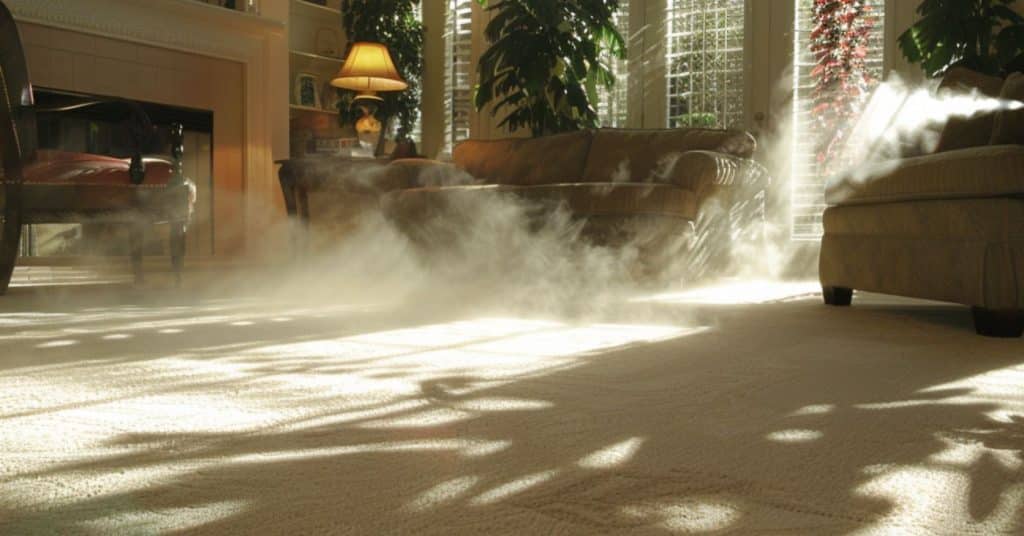We’ve all been there—stepping on a freshly cleaned carpet, only to be met with that squishy, damp feeling underfoot. It’s a common dilemma following a thorough carpet cleaning: how long until we can enjoy our carpets without that uncomfortable wetness?
The drying time can indeed feel like a mystery, leaving us tiptoeing around our own homes, waiting for that moment when everything feels just right again.
Understanding the factors that influence drying times can transform our approach to carpet cleaning, turning an exercise in patience into a well-planned activity.
We have discussed about how much time it takes to clean carpets. In this guide, we offer insights into what affects drying times and how to expedite them without compromising the cleanliness and longevity of your carpets.
If you look for carpet cleaner in Melbourne, you can always contact us.
Understanding the Carpet Cleaning Process
Types of Carpet Cleaning Methods
In our journey to get carpets back to their pristine condition, several carpet cleaning methods come into play, each with its own set of benefits.
Hot water extraction, commonly known as steam cleaning, uses high-pressure hot water to agitate carpet fibers and dissolve dirt. This method is highly effective but requires the longest drying time.
Dry cleaning, utilizing minimal moisture and specialized compounds to remove soil and stains, offers a quicker drying alternative.
Foam cleaning and bonnet cleaning are other options, each useful for specific situations and soil levels. Choosing the right method hinges on the carpet’s material, usage, and the desired outcome.
Factors That Affect the Drying Time
The path to dry carpets is littered with variables that can extend or shorten the drying period.
Airflow in the room plays a crucial role; the more air circulates, the faster moisture evaporates.
Humidity levels are another critical factor; higher humidity means slower drying times, as moist air slows the evaporation process. The temperature also affects drying speed, with warmer air speeding up evaporation.
Lastly, the carpet’s thickness and the cleaning method used directly influence drying time. Thicker carpets and those cleaned with more water take longer to dry. Understanding these factors helps us accelerate the drying process without compromising the results.
Average Drying Times for Carpet Cleaning
Navigating the aftermath of carpet cleaning involves a bit of patience, especially when waiting for carpets to dry. The drying time can vary significantly based on the cleaning method chosen.
Let’s dive into the specifics.
Hot Water Extraction or Steam Cleaning
How Long Does Carpet Take to Dry After Steam Cleaning
Hot water extraction, commonly referred to as steam cleaning, injects hot water and cleaning solutions deep into the carpet fibers. Extracting this mixture afterward removes dirt and debris.
Carpets typically take anywhere from 6 to 12 hours to dry after undergoing steam cleaning. However, this duration can extend up to 24 hours depending on factors like air circulation, humidity, and temperature within the home. Turning on fans or dehumidifiers can cut down drying time considerably.
You can check our guide to learn more tips on how to dry carpet after steam cleaning.
Dry Cleaning Methods
Contrary to steam cleaning, dry cleaning methods, which include several techniques like dry foam, dry chemical, and compound cleaning, offer the advantage of minimal to no drying time.
These methods use special powders or cleaning solutions that attach to dirt particles. A mechanical brush or machine then agitates the carpet, and the residue is vacuumed away.
Most carpets cleaned through dry methods are dry and ready for use almost immediately or within an hour at most.
By understanding these average drying times, homeowners can plan their carpet cleaning sessions better, ensuring minimal disruption to household routines and activities.
Tips to Speed Up the Drying Process
Understanding how to quicken the drying time of carpets after cleaning can significantly reduce inconvenience, enabling spaces to be usable sooner. Here, we’ll share some effective tips.
Improve Air Circulation
Opening windows and doors can drastically improve air movement in a room, facilitating faster drying. We find that even a slight breeze can make a noticeable difference. Remember, though, if it’s raining or very humid outside, sticking to indoor methods is best to avoid prolonging the drying process.
Use Dehumidifiers and Fans
Strategically placing fans and dehumidifiers in the room works wonders for expediting drying times. Fans help by moving air over the carpet’s surface, while dehumidifiers reduce moisture in the air, allowing the carpet to dry quicker. It’s like giving the wet carpet a much-needed nudge towards dry land.
Opt for Professional Equipment
While fans and open windows do a great job, sometimes bringing in the big guns—like professional-grade air movers and dehumidifiers—can get the job done faster. These tools are more powerful than your average household fan or dehumidifier, cutting down drying time significantly. Renting these may be worth considering for those impatient to get their rooms back in order.
The Impact of Humidity and Temperature
Seasonal Considerations
Understanding the role seasons play in carpet drying times can significantly inform our approach to scheduling our carpet cleaning.
For example, during summer, the hot and sometimes humid conditions may well seem ideal for quick drying but can actually extend drying times if the air is saturated with moisture.
Conversely, winter presents its own set of challenges. Although colder air may well hold less moisture, leading us to believe carpets would dry faster, the lack of open windows for air circulation and often the use of heating can make the drying process slower than expected. Adjusting cleaning schedules according to the season can help us achieve more efficient drying times.
Indoor Climate Control
Managing the indoor climate is crucial for optimizing carpet drying times. Here’s the deal: air conditioners and dehumidifiers become our best friends post-carpet cleaning.
These tools don’t just cool down or heat up our spaces; they control the humidity levels, making them ideal for use after carpet cleaning, especially in extreme weather conditions.
In humid conditions, a dehumidifier pulls excess moisture from the air, speeding up the drying process. During colder months, heating systems help, but it’s the humidity we need to watch out for.
Ensuring a balance in our indoor climate not only promotes faster drying but also creates a comfortable environment for us to return to.
When Can You Walk on Your Carpet Again?
After a carpet cleaning session, waiting to tread on it again can feel like an eternity. However, the type of cleaning method used plays a significant role in this waiting period.
Typically, for dry cleaning methods, the wait time is considerably shorter. You can usually walk on the carpet within a few hours. But for hot water extraction methods, it’s a bit longer.
In the latter case, we recommend waiting at least 6 to 8 hours before walking on your carpet. If you’re equipped with professional advice, using air movers or fans can significantly reduce this time. We always suggest wearing clean socks or shoe covers to avoid reintroducing dirt onto the surface.
Remember, every minute counts in achieving that perfectly dry and fresh carpet. By following these guidelines, you’ll ensure a quicker, safer post-cleaning experience.
Preventing Mold and Mildew Growth
Why Quickly Drying Is Crucial
Quick drying of carpets post-cleaning isn’t just about speed; it’s about hygiene and the longevity of your flooring. Left damp, carpets become breeding grounds for mold and mildew, compromising air quality and potentially causing health issues. Fast drying ensures these unwelcome guests don’t find a home in your fibers.
Proactive Measures Post-Cleaning
Taking active steps immediately after cleaning can make a big difference in drying time and prevent mold and mildew. First, we recommend opening windows to promote air circulation, assuming the weather outside supports this action. If not, or as an additional measure, running fans or air conditioners helps lower humidity levels and speeds up the drying process.
Using a dehumidifier in the room with the wet carpet pulls moisture from the air, directly attacking one of the main culprits behind slow drying times.
Lastly, if feasible and safe, lifting the carpet slightly to allow air to circulate underneath can further reduce drying time and discourage mold from settling in. Each of these steps, taken together or individually, supports a rapid drying process, keeping your carpets clean, dry, and healthy.
See more:

